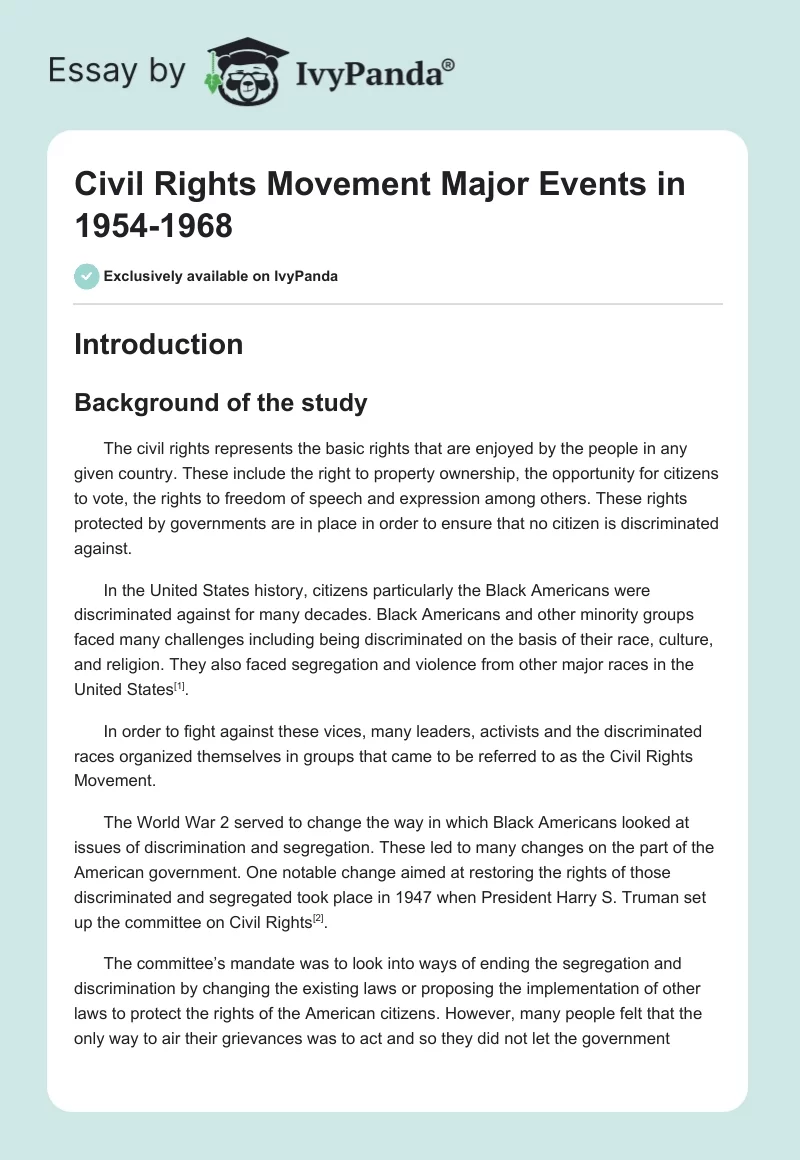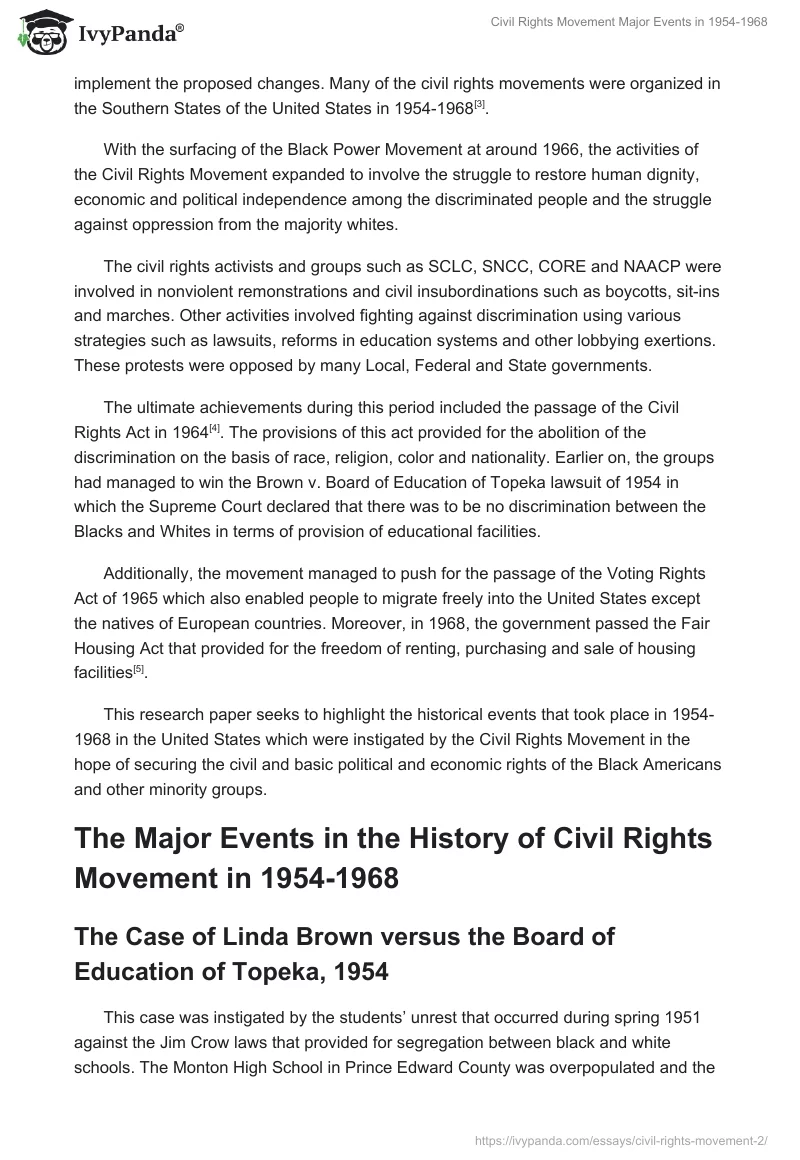- Introduction
- The Major Events in the History of Civil Rights Movement in 1954-1968
- Changes in Tactics from Litigation Strategies to Mass Action
- The Montgomery Bus Boycott (1955-1956)
- Reuniting Little Rock (1957)
- The Sit-ins of 1960s
- The Assassinations and the Poor people’s March (1968)
- Conclusion
- Works Cited
Introduction
Background of the study
The civil rights represents the basic rights that are enjoyed by the people in any given country. These include the right to property ownership, the opportunity for citizens to vote, the rights to freedom of speech and expression among others. These rights protected by governments are in place in order to ensure that no citizen is discriminated against.
In the United States history, citizens particularly the Black Americans were discriminated against for many decades. Black Americans and other minority groups faced many challenges including being discriminated on the basis of their race, culture, and religion. They also faced segregation and violence from other major races in the United States.
In order to fight against these vices, many leaders, activists and the discriminated races organized themselves in groups that came to be referred to as the Civil Rights Movement.
The World War 2 served to change the way in which Black Americans looked at issues of discrimination and segregation. These led to many changes on the part of the American government. One notable change aimed at restoring the rights of those discriminated and segregated took place in 1947 when President Harry S. Truman set up the committee on Civil Rights.
The committee’s mandate was to look into ways of ending the segregation and discrimination by changing the existing laws or proposing the implementation of other laws to protect the rights of the American citizens. However, many people felt that the only way to air their grievances was to act and so they did not let the government implement the proposed changes. Many of the civil rights movements were organized in the Southern States of the United States in 1954-1968.
With the surfacing of the Black Power Movement at around 1966, the activities of the Civil Rights Movement expanded to involve the struggle to restore human dignity, economic and political independence among the discriminated people and the struggle against oppression from the majority whites.
The civil rights activists and groups such as SCLC, SNCC, CORE and NAACP were involved in nonviolent remonstrations and civil insubordinations such as boycotts, sit-ins and marches. Other activities involved fighting against discrimination using various strategies such as lawsuits, reforms in education systems and other lobbying exertions. These protests were opposed by many Local, Federal and State governments.
The ultimate achievements during this period included the passage of the Civil Rights Act in 1964. The provisions of this act provided for the abolition of the discrimination on the basis of race, religion, color and nationality. Earlier on, the groups had managed to win the Brown v. Board of Education of Topeka lawsuit of 1954 in which the Supreme Court declared that there was to be no discrimination between the Blacks and Whites in terms of provision of educational facilities.
Additionally, the movement managed to push for the passage of the Voting Rights Act of 1965 which also enabled people to migrate freely into the United States except the natives of European countries. Moreover, in 1968, the government passed the Fair Housing Act that provided for the freedom of renting, purchasing and sale of housing facilities.
This research paper seeks to highlight the historical events that took place in 1954-1968 in the United States which were instigated by the Civil Rights Movement in the hope of securing the civil and basic political and economic rights of the Black Americans and other minority groups.
The Major Events in the History of Civil Rights Movement in 1954-1968
The Case of Linda Brown versus the Board of Education of Topeka, 1954
This case was instigated by the students’ unrest that occurred during spring 1951 against the Jim Crow laws that provided for segregation between black and white schools. The Monton High School in Prince Edward County was overpopulated and the conditions in the school were not conducive, therefore the students decided to mass act with the help of the NAACP.
This incidence was part of five other cases that are regarded to as the Brown v. Board of Education. In 1954, the US Supreme Court made a ruling to the effect that it was unconstitutional to practice segregation along racial lines. In addition, the Supreme Court also declared two boards of education as being also unconstitutional.
These were the 1899 education board and the 1896 Plessy v. Ferguson provision. This ruling saw an increase in the number of blacks seeking education. Further, the activities of the Black Press in highlighting the stories of professional Blacks with jobs and those leading modest lives helped to encourage more blacks into participating in the educational programmes.
Changes in Tactics from Litigation Strategies to Mass Action
The early strategies of Civil Rights Movement involved calling for reforms in the education systems, litigations and rallying for legislative changes. It was not until they won the Linda Brown’s case against the Board of Education of Topeka that the Movement decided to adopt a more radical way of calling for change.
This change of tactic saw the emergence of boycotts, marches, sit-ins and freedom rides among other strategies. These were conducted by churches and other community organizations that recruited volunteers who were willing to take part in the mass actions.
This proved to be a more productive means of calling for change as compared to the earlier tactics of filing lawsuits. The first boycott to be staged occurred at a gas station in Mississippi that refused to offer resting areas for Blacks. This was followed by a year-long bus boycott in Montgomery initiated by the Montgomery Improvement Association under the leadership of Dr. Martin Luther King.
This boycott succeeded in wining a Federal Court’s ruling that directed the Montgomery buses to reconcile its bus services.
In 1957, Dr. Luther and other church leaders such as Rev. John Duffy and Rev. T. J. Jemison joined forces to form the Southern Christian Leadership Conference (SCLC) that was involved in provision of training and financial support to Civil Rights activists. SCLC was however non-violent in its course to fight racism and segregation. Further, SCLC was involved in programs that taught literacy among the Blacks in order to enable them to participate in the Voting process.
The Montgomery Bus Boycott (1955-1956)
The boycott was brought about by the action of Rosa Park who refused to offer her sit to a white passenger in 1955. She was arrested and charged for violating the provisions of the local bus regulations. She was following the decisions that had been agreed upon during the NAACP meeting in Tennessee in which she was the NAACP secretary.
Her arrest pushed the leadership of NAACP with the support of the larger Montgomery Black Americans to organize a bus boycott that lasted well over one year. The boycott came to an end upon the Federal Court’s ruling of 1956 which forced the Montgomery buses to desegregate their services.
Reuniting Little Rock (1957)
The reunion was prompted by the case of nine Black American students who had been chosen to attend the Little Rock Central High School. They were however denied entry into the school due to the presence of the National Guard who had been called upon by the Kansas Governor to prevent the entry of the nine into the school. Earlier on, the federal court had ordered all schools to desegregate their services and accommodate blacks in white schools through the famous Brown decision.
However, the Governor could not agree with the court’s ruling and it had to take President Eisenhower’s intervention that introduced the 101st Airborne Division in order to force the National Guard out and provide protection to the nine students and many more. The move by the Little Rock schools to desegregate inspired other schools in the Southern States to follow the order given by the federal court.
The Sit-ins of 1960s
It started off as simple sit-in at Woolworth’s organized by four students from the North Carolina Agricultural & Technical College who were protesting against the policies at Woolworth’s that segregated against Black Americans. It further inspired similar sit-ins in many places across the southern region of the United States.
The sit-ins later expanded to include demonstrations in parks, beaches, theaters, and museums among other public places. Later the students who started the sit-ins organized themselves in a group known as the Students Nonviolent Coordinating Committee (SNCC) which was later involved in other activities such as freedom rides.
After the 1960 sit-ins, many events occurred all of which were meant to send a clear message that the people needed change urgently. These were the freedom rides of 1961, the voter registrations of 1962, the integration of Mississippi universities of 1965 and the Birmingham campaign of 1963-1964 among others.
The Assassinations and the Poor people’s March (1968)
This assassination involved the murder of the King of Memphis in 1968 after he had delivered an inspiring speech over the death of two black workers at their workplace. The assassination was followed by numerous protests across major cities in the United States which led to a lot of economic damages. The leadership of the movement against racism was taken over by the Coretta Scott King who together with the King of Memphis’ children led protests against racism and discrimination.
Conclusion
The paper has given an in-depth account of the history of civil rights movement which was meant to fight against discrimination and segregation in order to ensure that the people got their basic civil, economic and political rights that they had been denied for many decades.
The movements’ activities became radical as of 1954 after the end of World War 2 due to changes in the way black people were treated and the way they looked at themselves. These radical changes in the approaches of the civil rights movements led to major events that took place as of 1954-1968. These events have been highlighted in the research paper in a chronological manner.
Works Cited
African American History. Civil rights movement. New York: Weigl Publishers Inc., 2009. Print.
Arsenault, Raymond. Freedom Riders: 1961 and the Struggle for Racial Justice. New York: Oxford University Press, 2006. Print.
Carson, Clayborne. In Struggle: SNCC and the Black Awakening of the 1960s.
Cambridge, MA: Harvard University Press, 1980.
Goluboff, Risa L. The Lost Promise of Civil Rights. Cambridge, MA: Harvard University Press, 2007. Print.
Garrow, David J. Bearing the Cross: Martin Luther King and the Southern Christian Leadership Conference. New York: William Morrow, 1986.


